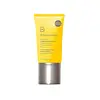What's inside
What's inside
 Key Ingredients
Key Ingredients

 Benefits
Benefits

 Concerns
Concerns

 Ingredients Side-by-side
Ingredients Side-by-side

Water
Skin ConditioningZinc Oxide
Cosmetic ColorantCaprylic/Capric Triglyceride
MaskingDimethicone
EmollientDicaprylyl Carbonate
EmollientCoco-Caprylate/Caprate
EmollientButyloctyl Salicylate
Skin ConditioningPropanediol
SolventLauryl Polyglyceryl-3 Polydimethylsiloxyethyl Dimethicone
Skin ConditioningPolyhydroxystearic Acid
EmulsifyingPolymethylsilsesquioxane
Tranexamic Acid
AstringentAloe Barbadensis Leaf Juice
Skin ConditioningHibiscus Sabdariffa Flower Extract
Skin ConditioningPongamia Pinnata Seed Extract
Skin ConditioningSaccharide Isomerate
HumectantSodium Hyaluronate
HumectantEthylhexylglycerin
Skin ConditioningDimethicone/Polyglycerin-3 Crosspolymer
CleansingMagnesium Hydroxide
AbsorbentTriethoxycaprylylsilane
Magnesium Sulfate
Disteardimonium Hectorite
StabilisingSodium Chloride
MaskingTriethyl Citrate
MaskingSodium Citrate
BufferingTetrasodium Glutamate Diacetate
Phenoxyethanol
PreservativePotassium Sorbate
PreservativeWater, Zinc Oxide, Caprylic/Capric Triglyceride, Dimethicone, Dicaprylyl Carbonate, Coco-Caprylate/Caprate, Butyloctyl Salicylate, Propanediol, Lauryl Polyglyceryl-3 Polydimethylsiloxyethyl Dimethicone, Polyhydroxystearic Acid, Polymethylsilsesquioxane, Tranexamic Acid, Aloe Barbadensis Leaf Juice, Hibiscus Sabdariffa Flower Extract, Pongamia Pinnata Seed Extract, Saccharide Isomerate, Sodium Hyaluronate, Ethylhexylglycerin, Dimethicone/Polyglycerin-3 Crosspolymer, Magnesium Hydroxide, Triethoxycaprylylsilane, Magnesium Sulfate, Disteardimonium Hectorite, Sodium Chloride, Triethyl Citrate, Sodium Citrate, Tetrasodium Glutamate Diacetate, Phenoxyethanol, Potassium Sorbate
Water
Skin ConditioningEthylhexyl Methoxycinnamate
UV AbsorberDimethicone
EmollientGlycerin
HumectantDrometrizole Trisiloxane
UV AbsorberTerephthalylidene Dicamphor Sulfonic Acid
UV AbsorberPropylene Glycol
HumectantTitanium Dioxide
Cosmetic ColorantAlcohol Denat.
AntimicrobialTriethanolamine
BufferingStearic Acid
CleansingPotassium Cetyl Phosphate
EmulsifyingNylon-12
Palmitic Acid
EmollientPEG-100 Stearate
Glyceryl Stearate
EmollientPhenoxyethanol
PreservativeCetyl Alcohol
EmollientCellulose
AbsorbentBis-Ethylhexyloxyphenol Methoxyphenyl Triazine
Skin ConditioningDiethylamino Hydroxybenzoyl Hexyl Benzoate
UV FilterCitric Acid
BufferingAluminum Hydroxide
EmollientCaprylyl Glycol
EmollientSodium Cocoyl Sarcosinate
CleansingCarbomer
Emulsion StabilisingTocopherol
AntioxidantTromethamine
BufferingScutellaria Baicalensis Extract
AntimicrobialAcrylamide/Sodium Acryloyldimethyltaurate Copolymer
Emulsion StabilisingIsohexadecane
EmollientXanthan Gum
EmulsifyingMyristic Acid
CleansingDisodium EDTA
Adenosine
Skin ConditioningPolysorbate 80
EmulsifyingArginine
MaskingMannitol
HumectantDisodium Adenosine Triphosphate
Skin ConditioningRna
Skin ConditioningPyridoxine Hcl
Skin ConditioningSorbitan Oleate
EmulsifyingSorbitol
HumectantPentylene Glycol
Skin ConditioningBHT
AntioxidantHistidine Hcl
Skin ConditioningZea Mays Kernel Extract
Sodium Chloride
MaskingFaex Extract
Skin ConditioningPhenylalanine
MaskingMentha Piperita Extract
CleansingRosa Gallica Flower Extract
AstringentTyrosine
MaskingSorbic Acid
PreservativeWater, Ethylhexyl Methoxycinnamate, Dimethicone, Glycerin, Drometrizole Trisiloxane, Terephthalylidene Dicamphor Sulfonic Acid, Propylene Glycol, Titanium Dioxide, Alcohol Denat., Triethanolamine, Stearic Acid, Potassium Cetyl Phosphate, Nylon-12, Palmitic Acid, PEG-100 Stearate, Glyceryl Stearate, Phenoxyethanol, Cetyl Alcohol, Cellulose, Bis-Ethylhexyloxyphenol Methoxyphenyl Triazine, Diethylamino Hydroxybenzoyl Hexyl Benzoate, Citric Acid, Aluminum Hydroxide, Caprylyl Glycol, Sodium Cocoyl Sarcosinate, Carbomer, Tocopherol, Tromethamine, Scutellaria Baicalensis Extract, Acrylamide/Sodium Acryloyldimethyltaurate Copolymer, Isohexadecane, Xanthan Gum, Myristic Acid, Disodium EDTA, Adenosine, Polysorbate 80, Arginine, Mannitol, Disodium Adenosine Triphosphate, Rna, Pyridoxine Hcl, Sorbitan Oleate, Sorbitol, Pentylene Glycol, BHT, Histidine Hcl, Zea Mays Kernel Extract, Sodium Chloride, Faex Extract, Phenylalanine, Mentha Piperita Extract, Rosa Gallica Flower Extract, Tyrosine, Sorbic Acid
 Reviews
Reviews

Ingredients Explained
These ingredients are found in both products.
Ingredients higher up in an ingredient list are typically present in a larger amount.
Dimethicone is a type of synthetic silicone created from natural materials such as quartz.
What it does:
Dimethicone comes in different viscosities:
Depending on the viscosity, dimethicone has different properties.
Ingredients lists don't always show which type is used, so we recommend reaching out to the brand if you have questions about the viscosity.
This ingredient is unlikely to cause irritation because it does not get absorbed into skin. However, people with silicone allergies should be careful about using this ingredient.
Note: Dimethicone may contribute to pilling. This is because it is not oil or water soluble, so pilling may occur when layered with products. When mixed with heavy oils in a formula, the outcome is also quite greasy.
Learn more about DimethiconePhenoxyethanol is a preservative that has germicide, antimicrobial, and aromatic properties. Studies show that phenoxyethanol can prevent microbial growth. By itself, it has a scent that is similar to that of a rose.
It's often used in formulations along with Caprylyl Glycol to preserve the shelf life of products.
Chances are, you eat sodium chloride every day. Sodium Chloride is also known as table salt.
This ingredient has many purposes in skincare: thickener, emulsifier, and exfoliator.
You'll most likely find this ingredient in cleansers where it is used to create a gel-like texture. As an emulsifier, it also prevents ingredients from separating.
There is much debate on whether this ingredient is comedogenic. The short answer - comedogenic ratings don't tell the whole story. Learn more about comegodenic ratings here.
The concensus about this ingredient causing acne seems to be divided. Research is needed to understand if this ingredient does cause acne.
Scrubs may use salt as the primary exfoliating ingredient.
Learn more about Sodium ChlorideWater. It's the most common cosmetic ingredient of all. You'll usually see it at the top of ingredient lists, meaning that it makes up the largest part of the product.
So why is it so popular? Water most often acts as a solvent - this means that it helps dissolve other ingredients into the formulation.
You'll also recognize water as that liquid we all need to stay alive. If you see this, drink a glass of water. Stay hydrated!
Learn more about Water